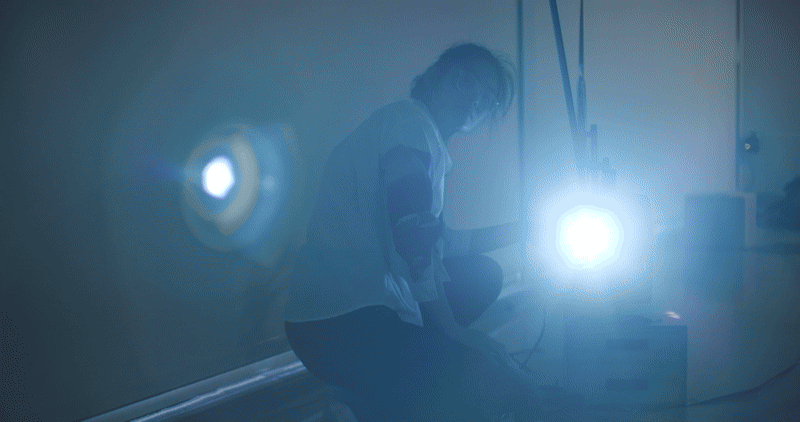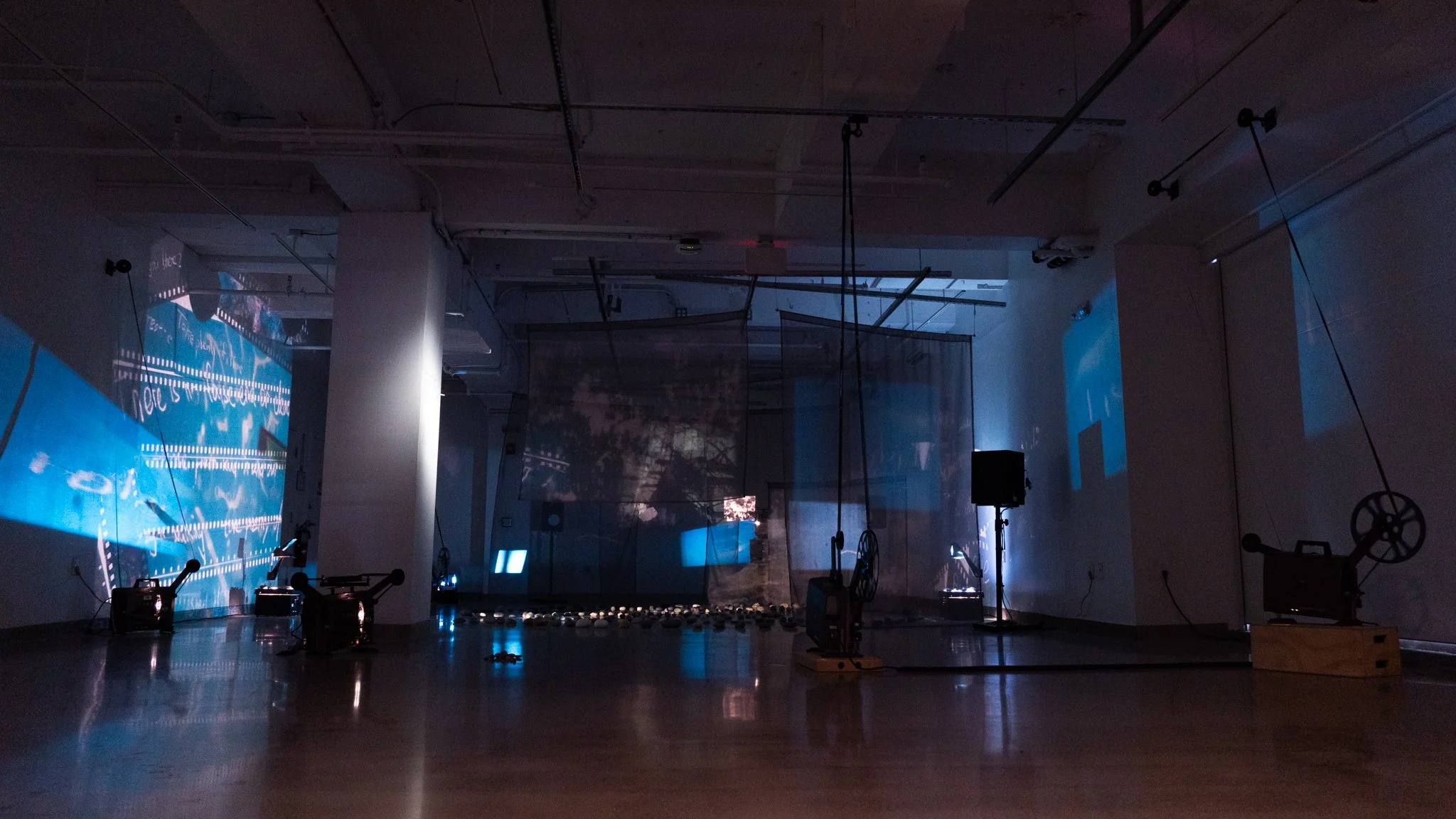Yue Hua, As a bisexual born and raised in China, I understand the underlying pressure of expressing oneself. Trained as a painter, I enjoy experimenting with mixed media collages and hands-on cameraless filmmaking techniques. I fell in love with 16mm analog film with its dream-like texture and infinite possibility, which has become the main medium of my creation
Yue Hua
Artist Statement
My artistic journey stems from self-exploration and the desire to break free from traditional roles, particularly the constraints placed on women. Although many of my works originate from self-expression, they gradually evolved into deeper themes, such as the relationship of spirit and body, the identity dilemma of Asian queer, the power of language, the female perspective, and the search for belonging. Collage opens gaps between imagination and familiar ideas. Image and sound are bridges spanning the distance between what is spoken and unspoken. Chinese and English complement each other, revealing a liminal area between personal narrative and thinking limitations in different cultural contexts. Experimenting with images, sound, poems, and language, I explore the poetic, abstract, and nonlinear possibilities of storytelling, extracting new meanings from fragmented images
Instagram: yuehua_yvette
Website: yuehua.co
Trace on My Body. A film about self-acceptance, and a conversation with self. In spring 2023, a physical illness forced me to re-examine my relationship with my body. Scars, spots, skin, hair, and my unflattering voice, everything belongs to my body.
Interview with Yue
Hi Yue, tell us about your background. How and when did you first start to make video?
My artistic journey began as a painter. I loved working with pencils, crayons, and all kinds of painting tools, embracing the messiness and creativity that came with it. This playful exploration was the foundation of my creative practice.
I first venture into filmmaking or video making in my second year of undergraduate studies. At that time, I was drawn to the medium simply because I thought films and videos was cool. I was a fan for filmmaker, such as Hirokazu Koreeda and Andrei Tarkovsky. For me, everything starts with curiosity, and that same curiosity continues to fuel my work today.
How do you begin to work? What is your process like?
My creative process feels like piecing together a puzzle from fragments of life—a journey of self-discovery through constant experimentation and bursts of spontaneity.
I always keep a journal to jot down my thoughts and note the little things that happen around me. I’m a firm believer in the power of life’s tiny moments; personal stories often carry universal themes. Alongside journaling, I use mind maps, videos, and voice memos to capture and reflect on my experiences.
When a particular moment or experience sparks strong emotions or lingering questions, I know it’s time to create. That spark leads me to dive into research and experimentation, resulting in art that doesn’t necessarily provide answers but invites exploration and dialogue.
How do you approach expressing personal and complex themes like the identity dilemma of being Asian and queer through your art?
Expressing such deeply personal and complex themes is both a challenge and a continual evolution for me, involves vulnerability and navigating cultural and societal expectations. It’s a journey where pain and discomfort are often present, but personal growth follows.
My approach begins with being brave and honest with my emotions. I break down the details of my experiences, ask questions, and allow different feelings to flow without rushing to find answers. As Agnès Varda, a filmmaker I admire, once said: “I am always very precisely implicated in my films, not through narcissism but through honesty in my approach.”
I see my exploration happening on both conscious and unconscious levels. To express these themes, I use language, abstract or symbolic imagery, and poetry to allow my work to communicate beyond the rational. This approach creates space for viewers to engage with the ideas in their own unique ways, fostering connection and dialogue.
Over time, I’ve come to see art as a way to process and express these identities without needing to fully define or resolve them. Instead, I embrace the complexity and fluidity of who I am, allowing my work to evolve along with me.
Part of Trace on My Body(film)
In what ways have your cultural and personal experiences as a bisexual artist born and raised in China influenced your artistic vision and storytelling?
There’s so much to say, but what has impacted me the most is growing up in a culture that doesn’t encourage free expression and imposes rigid social expectations, especially for women. From a young age, I felt an invisible pressure to conform, and for a long time, I was too scared to face my emotions or express myself.
In mainstream media, I rarely saw representation of LGBTQ+ individuals or female artists. The dominant narratives centered on traditional roles, like housewives, which left me feeling isolated and questioning my identity. Without social support or role models, I often felt like I didn’t belong.
This experience built up a lot of frustration and anger within me. Once I began using art as a means of exploration and expression, it became a platform for advocacy and self-healing. Sharing my personal stories through art not only empowered me but also encouraged others—fellow artists and students alike—to bravely express themselves. I find massive freedom and support through personal storytelling.
Blue Bird, Six-16mm-Projection performance, 2024
Yue Hua
“I see creating in both languages as a conversation with myself, allowing me to explore my identity from multiple perspectives.”
What drew you to 16mm analog film as a medium, and how does its dream-like texture impact your creative process and narrative choices?
I was introduced to analog filmmaking while pursuing my MFA at Emerson College through an Analog Filmmaking class. Before that, I had only learned the concept of film but had never seen or touched 16mm film in person—there was barely any access to it in China when I was growing up.
Working with 16mm film immediately brought a sense of nostalgia for me. Its tactile quality reminded me of my childhood when analog still photography was still common. But beyond its texture, it’s the unique workflow of analog filmmaking that has deeply influenced my creative process and storytelling.
One example is non-sync sound filmmaking, which I practiced in the intro class. Without the ability to record sound during production, I was encouraged to think differently—telling stories through silence, visual textures, or text on the screen. This shifted my perspective on how narratives can unfold.
Another significant aspect of analog film is its unpredictability. Unlike digital film, where results are instant, with 16mm you often have to wait days or weeks to develop the film and see the outcome. The results are rarely what you planned, and this has taught me to embrace mistakes and imperfections as part of the creative process. It’s a journey of discovery, pushing me to think actively and experiment with new approaches. Additionally, the physicality of film allows for expansion into installations and performances, giving me the freedom to experiment and reimagine storytelling in innovative ways.
How does working across Chinese and English allow you to explore personal narratives, and what unique challenges or opportunities arise from this duality?
I don’t feel many challenges , though I sometimes need extra time to organize my thoughts while writing or reading. Once I dive deeper into an idea, what I want to express usually comes naturally.
I see countless opportunities in this duality. I’ve noticed I embody different personalities when using each language, shaped by the social roles I play in these two cultures. In English, I feel brave, straightforward, and rational—I can say no or stand up for myself. In Chinese, I see a more sensitive, euphemistic and restrained side of me, shaped by years of social and cultural expectations. Creating in both languages feels like having a conversation with myself, allowing me to explore my identity from multiple perspectives.
Language itself is also beautiful—certain words or phrases carry unique meanings in each language, offering a rich and immersive experience as I play with them. I have made three pieces, “Time is a loop”, I wish, Blue Bird and Trace on My Body, all involve text and image for narration. I think I will keep explore this duality aspect of it.
How do collage and cameraless filmmaking techniques help you create spaces for imagination and new interpretations within your work?
They allow me to break away from traditional storytelling and embrace a more intuitive, experimental approach. By layering found images, textures, and materials directly onto film or creating abstract compositions, I can transform everyday elements into imaginative, unexpected visuals.
These methods encourage spontaneity and open the door to reinterpretation. The process itself and my intuition guide me. This hands-on approach fosters exploration and invites viewers to engage with the work on a sensory and emotional level, sparking their own interpretations and connections.
Your earlier works focused on self-expression but later evolved to explore themes such as spirit, body, and belonging. What drove this shift, and how has it influenced the direction of your practice?
As I matured as an artist, I began to see my individual struggles and stories as a part of a larger narrative and driven by a growing desire to connect my personal experience to universal questions. Themes like identity, migration, and cultural belonging started to emerge naturally as I reflected on my place in the world. This evolution has expanded my practice to be more inclusive and multifaceted, blending the personal with the universal while exploring the tensions between internal and external realities.
When working with abstract and nonlinear storytelling, how do you ensure your work resonates emotionally with your audience while maintaining its poetic quality?
When creating abstract narratives, I ground it with authentic emotions and human experiences, which I think it’s the key to engage my audience. Human’s brain actually doesn’t need that much rational or linear storytelling. We all have the ability to imagine and communicate. So the poetic quality and my way of pieceing metaphor, imagery, texture and sounds together naturally create a space for audience to interprete and have conversations.
Describe a real-life situation that inspired you.
I had lots of big arguement with people that are matter to me. It is extremly tough to fight against the eager to run away and really be open and valuniable to each other. I remember moments where I would sit with friends, hold their hands, and let the tears flow together. In those tears, we found relief and understanding. I find the beauty and power of our capacity to truly connect and express our emotions, and it became a central theme in my work.
Dream Bubble, three channel video installation, 2024
Cine-labyrinth, Eight-Channel 16mm film installation, 2024







